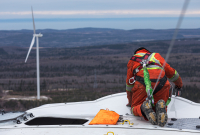Support strong Canadian climate journalism for 2025
After Canada’s worst wildfire season on record, Ottawa’s mini-budget was scant on fresh investments to prepare and protect Indigenous communities for a new era of fire.
In the federal fall economic statement tabled Tuesday, there were no new emergency preparedness program announcements for Indigenous communities.
There is also no mention of a national wildfire-fighting agency, a significant demand from civil society groups and opposition politicians all summer while Canada burned.
Historically, the fall economic statement provides estimates on Ottawa’s fiscal framework, Hadrian Mertins-Kirkwood, senior researcher at the Canadian Centre for Policy Alternatives, said.
“But I think climate is a good candidate for being featured in mini-budgets because the situation is evolving so quickly,” he said.
This year’s wildfire season saw over 95 First Nations evacuated from their communities, nearly doubling the previous worst wildfire season and carrying a quarter of a billion price tag so far.
Over the previous six months, there was already a significant dollop of funding, around $260 million, added to Indigenous Services Canada’s response to wildfire emergencies, among other climate disasters. In context, the baseline funding for the program administering that cash hovers around $29.3 million, according to the Department of Finance.
It’s expected the number of emergencies and evacuations will grow across Canada because of climate change, a 2022 audit on emergency preparedness in First Nations found.
If recent years are a sign, it could possibly force Ottawa to spend hundreds of millions more responding to climate emergencies in Indigenous communities each year.
The $260 million, largely used as a reactive measure to help First Nations through climate emergencies like wildfires, continues the pattern of Ottawa’s reactionary spending.
And yet, in three audits spanning over a decade, the auditor general has been pulling the fire alarm on Indigenous Services Canada to do more to prepare First Nations for climate emergencies.
The audits’ main criticism of the department’s current approach is that it’s failing Indigenous communities while keeping federal spending inefficient. Indigenous Services Canada reported every dollar spent preparing for emergencies could save the department six times the amount spent in reaction.
Ahead of the mini-budget, the conversation in Ottawa centred on the Liberal government’s course correction to fiscal constraints to navigate high interest rates.
Mertins-Kirkwood agrees, characterizing the mini-budget as penny-pinching, which isn’t the best news for the climate crisis response.
Timing matters on spending for climate policy to lay a foundation for net zero and reduce ballooning disaster response costs, he added.
“We know disasters are costing in the range of $10 billion in Canada. That’s forecasted to increase tenfold to $100 billion a year by 2050,” Mertins-Kirkwood explained.
It’s unclear if the 2024 budget will consider a looming wildfire crisis next summer. If new programs are announced next spring, some wonder if there will be enough time to streamline them ahead of wildfire season, which began in early May this year.
Fire professionals also told Canada’s National Observer that major wildfires will survive through winter, smouldering underground until the ground thaws.
If the hot, dry weather returns, Ottawa and the provinces could be caught flat-footed without any serious action from the federal government.
“Thoughtfully spending now to mitigate those impacts [of climate disasters] pays for itself,” Mertins-Kirkwood said.
“Climate adaptation pays for itself absolutely.”
Matteo Cimellaro / Canada’s National Observer / Local Journalism Initiative






Comments